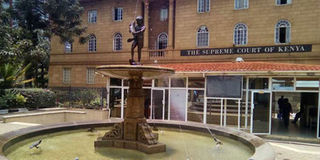Judiciary committed to dealing with corruption

The Supreme Court building in Nairobi. PHOTO | FILE | NATION MEDIA GROUP
What you need to know:
Corruption is a vice that gnaws at the heart of the Kenyan society.
It is, therefore, a continuous fight that institutions must wage, both by speaking out against it and punishing it resolutely.
There has been public discussion on corruption and economic crimes, especially in the public sector. A key focus of this debate has been how and why individuals either perceived to be corrupt or actually charged with corruption in courts of law are not doing time in jail.
The impediments to the war on corruption in Kenya are well chronicled in the report of the Task Force on the Review of the Legal, Policy and Institutional Framework for Fighting Corruption in Kenya, released late last year.
The task force, chaired by Attorney-General Githu Muigai, partly attributed the seemingly slow pace of resolving corruption and economic crime cases to “a plethora of constitutional references and judicial review applications lodged by suspects before or after arraignment in court”. However, it was unequivocal that the rule of law must never take a back seat.
“The fight against corruption should be waged within the framework of the Constitution, the applicable law, and the principles of the rule of law. Thus, notwithstanding the incessant public pressure on the fight against corruption and economic crime in all their facets, the tenets of due process and fair trial must be adhered to so that the fundamental rights and freedoms of innocent persons are not compromised in the name of fighting corruption,” the task force stated.
The administration of justice is a multi-agency effort that requires the highest standards of performance by every actor in the equation. What may appear like a simple and straightforward criminal matter at the court stage involves a number of parties and circumstances, each of which has an impact of one form or another on the efficiency or otherwise of the court process. These parties include the police, the prosecution, witnesses, advocates, and the courts.
HUMAN WEAKNESSES
The administration of justice is often characterised by human and systemic weaknesses and uncertainties attributable to various factors, ranging from plain inefficiency and incompetence to possible vested interests that have the potential to undermine the expeditious and successful management of cases.
According to the Judiciary’s Daily Court Returns Template, factors or weaknesses outside the purview of the Judiciary account for 70 per cent of reasons behind the slow pace of corruption and economic crimes matters in courts.
Sometimes courts have to entertain adjournments in the public interest. The alternative course of action would result in a phenomenally high rate of acquittals when witnesses are persistently absent.
The facts as recorded by judicial officers present an equally negative picture of prosecutorial performance in the expeditious and efficient disposal of corruption cases.
The Judiciary remains committed to the highest standards of efficiency, probity, and accountability in its judicial and administrative conduct. Among the Judiciary’s notable anti-corruption initiatives was the establishment of the Anti-Corruption and Economic Crimes Division of the High Court and special magistrates courts.
As a result of reforms in the Judiciary, 2016 alone has seen 17 convictions for corruption and economic crimes. The Judiciary has also hosted a meeting of the National Council on the Administration of Justice. Practice directions have been developed under this framework and will be gazetted in the next few weeks.
WORK ETHIC
Of course we cannot bury our heads in the sand by defending the work ethic of each judicial officer, but suffice it to say that best practice frameworks and systems are now in place to identify and deal with judicial and non-judicial officers who do not meet the high threshold of conduct and performance.
Management and, where necessary, the Judicial Service Commission, have spared no effort to enforce policies and apply sanctions to move the institution in the right direction, as set out in the Constitution and the Judiciary Transformation Framework and Strategic Plan.
The Office of the Judiciary Ombudsperson has been instrumental in improving internal accountability. The Judicial Service Commission Investigations Unit is staffed with professional personnel. To forestall malpractices among staff, the Judiciary has also set up an Internal and Risk Management Directorate.
Corruption is a vice that gnaws at the heart of the Kenyan society. It is, therefore, a continuous fight that institutions must wage, both by speaking out against it and punishing it resolutely.
Naim Bilal is director, public affairs and communication, Judiciary.




